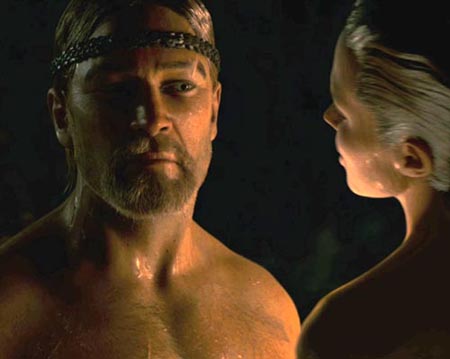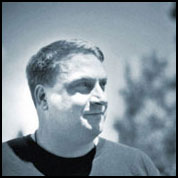« We Own the Night (2007) – Movie Review | Home | Tony Bennett: The Music Never Ends (2007) – Movie Review »
Beowulf (2007) – Movie Review
By Robert L. Jones | November 16, 2007

Through the miracle of computer technology, Ray Winstone looks like Russell Crowe and Angelina Jolie looks like herself on a Wella hair conditioner bottle
Something Rotten in Denmark
[xrr rating=2/5]
Beowulf. Featuring Ray Winstone, Anthony Hopkins, John Malkovich, Robin Wright Penn, Angelina Jolie, Crispin Glover, Sonje Fortag, Sharisse Baker-Bernard, Charlotte Salt, Julene Renee, Greg Ellis, Rik Young, Sebastian Roché, Leslie Zemeckis, Woody Schultz, Tyler Steelman, Brendan Gleeson, and Chris Coppola. Music by Alan Silvestri. Cinematography by Robert Presley. Production design by Doug Chiang. Costume design by Gabriella Pescucci. Edited by Jeremiah O’Driscoll. Based on the epic poem of Norse legend. Screenplay by Neil Gaiman and Roger Avary. Directed by Robert Zemeckis. (Paramount Pictures, 2007, color/IMAX and REAL-D 3-D, 113 minutes. MPAA rating: PG-13.)
If I were a snooty fillum critic, I’d probably call Robert Zemeckis’s rather loose adaptation of the Anglo-Saxon epic poem Beowulf “contrived.” Because I’m just a regular guy who doesn’t take a shine to euphemisms, I’ll just call it what it is: a rip-off. But this 3D special-effects extravaganza is not so much a rip-off of its two most oft-cited (and more worthy) predecessors, the Lord of the Rings trilogy and 300, as it is of the hard-earned greenbacks in my wallet.
This was supposed to be the movie that put Zemeckis back on top, and it has, at least for one weekend worth of box-office receipts. But, compared to his technologically groundbreaking movies Who Framed Roger Rabbit? and Forrest Gump, Beowulf pales, both visually and as entertainment—it’s a garbled mess, in both departments. Although its devotees proclaim Beowulf to be a “whole new kind of moviemaking” (Michael Medved), it’s really just an ill-conceived merging of two gimmicks: CGI and 3-D.
You’d think with all the battleaxes, swords, and daggers flying right at you, I would have at least flinched. Sorry, but I didn’t, not even once. You’d do better watching the 1953 Vincent Price 3-D horror flick House of Wax for real thrills and chills. As for amazing action sequences, skip this one and instead click on the Schwarzenegger action classic Predator next time you log in at Netflix. That movies decades older seem more visually sophisticated makes me wonder just how much of his $160 million budget Zemeckis actually spent on visual effects.
What he spent, he blew on a process called “motion capture,” which is similar to Rotoscoping: Actors’ movements are recorded and merged with their computerized likenesses. Thus, we don’t see pudgy, stocky actor Ray Winstone as Beowulf running, jumping, and bouncing off walls with the ease of Spiderman; we see a buff, elongated, digital representation of Winstone performing these implausible feats.
Zemeckis first used this process in his Christmas movie The Polar Express. Motion-capture rendered his cast of youngsters so robotic and soulless it ought to have been titled The Stepford Children. Likewise, the real-but-fake-looking animated characters in Beowulf are the worst of both worlds: too awkward-looking to be cartoons, and too cartoonish to empathize with. Before directing another movie in this process, Zemeckis should spend a year with the techies at Pixar Studios. If they can move me to tears with Finding Nemo and to cheer for Mr. Incredible and Elastigirl, then there’s probably something they get that he doesn’t.
It’s called “a great story,” something Zemeckis used to know how to tell. And it’s not as if there isn’t a great story already in the source material, either. It’s that screenwriters Neil Gaiman and Roger Avary couldn’t decide whether they wanted an epic or a satire. The results aren’t so much ambivalent as schizophrenic.
Beowulf opens with a sweeping crane shot as the camera swoops over the frozen tundra of Denmark, 507 A.D., and the hills are alive with the sound of . . . drunken Thanes. They’re whooping it up in the mead hall of Hrothgar, the loutish king (Anthony Hopkins, who’s great even when he phones it in, as he does here), whose evening of merrymaking and debauchery is interrupted by an uninvited party guest, Grendel (Crispin Glover). A drooling monster, who speaks what sounds like Klingon, screams and cries when he doesn’t get his way, and bites the heads off anyone who defends against his tantrums, the resemblance between Grendel and my toddler son Evan is uncanny. What makes it truly ghastly, though, is that the wretched gate-crasher is ten feet tall.
After leaving Hrothgar’s residence an utter shambles in his wake, Grendel retreats to his underground lair. When Hrothgar orders the mead hall closed, his girly-man advisor Unferth (John Malkovich, at his unctuous best in the movie’s best performance) recommends converting to the newfangled deity from Rome, Jesus Christ, in order to defeat Grendel. On cue, Hopkins rejoins: “The Gods will do nothing for us that we can’t do for ourselves. What we need is a hero.”
What we get instead is Beowulf, who has the makings of a hero, but the script and ridiculous special effects undermine whatever heroism he can muster. At every available opportunity, he introduces himself by shouting “I am Beowulf!” with exactly the same cadence, volume, and facial grimacing that Gerard Butler used for “This is Sparta!” in 300.
Another reason his heroism is hard to grasp is because the writers throw in a lot of bawdy fart and cleavage jokes, which have some mild shock value; but this is not supposed to be Monty Python and the Holy Grail. In Zemeckis’s hands, the puns come off more like a bad imitation of “Beavis and Butt-Head.” For example, when he faces down Grendel in what ought to have been the movie’s showdown, Beowulf strips naked (something else my two-year-old also does a lot lately); and as he swashbuckles his way across the screen, roof beams, goblets, and swords provide convenient cover for a certain feature of his anatomy. As if we didn’t get this sight gag, recycled from the Austin Powers flicks and old “Benny Hill” routines, a handy maiden speculates, “I wonder if Beowulf’s strength is in his legs. All three of them.” Wink wink, nudge nudge. Get it?
Having been dismembered by Beowulf’s (actual, not figurative) sword, Grendel slinks back to die at the lair, from which we learn his vengeful mother sent him on his murderous rampage. Mother is a gold-plated siren with Prada stiletto heels growing out of her cloven feet and a twelve-foot-long armadillo’s tail protruding from her posterior. She’s more-or-less acted by Angelina Jolie, who’s perfectly cast for this odd filmmaking genre. Jolie’s breakout starring role was playing a video-game heroine. Alas, her performance couldn’t quite capture the feeling and subtlety of the Sony PlayStation version.
Our hero pays a visit to her lair to finish the job and free Denmark’s people from her wrath. Once he arrives, though, she casts a spell over him. “Give me a son, and I shall make you the greatest king that ever lived,” she tells Beowulf sweetly, in what has got to be the most laughable Ingrid Bergman impression on record.
Still, she manages to seduce him, despite looking like Mick Jagger in drag. Beowulf returns to Hrothgar and his queen, Wealthow, played by Robin Wright Penn. Though she gives a compelling performance, the lifelessness in her eyes renders it bloodless (I prefer to remember her as the Princess Bride). Beowulf concocts a tall tale of how he faced down and dispatched “the old hag,” though Hopkins is skeptical.
Suddenly, the film gets serious. Hrothgar commits suicide, leaving his queen and kingdom to Beowulf. Unfortunately, the movie switches gears too abruptly into this agonizing second act, which was exceptionally well-written, even Shakespearean in its treatment of Beowulf’s dilemma.
Having gotten everything he wanted, Beowulf finds that his crown weighs heavily upon him, as does his conscience. Drained of his lust for love and battle, he contemplates his hollow victory. “Now, nothing is as good as it should have been,” he cries.
Yet as soon as the movie redeems itself, it switches gears back again to an anti-climactic video-game finale. Whether Beowulf himself triumphs I will not divulge; that is, sadly, beside the point. What seemed more important to its makers was that special-effects sequences triumphed at the cost of coherence and drama.
I have no qualms with digital effects as long as they are integral to the storytelling, something director Zack Snyder managed masterfully in 300. But this anti-cinematic picture represents CGI at its worst: There are no difficult camera angles to figure out, no organic visual montages to solve, just the lazy man’s computerized quick fix of wowing the audience with impossible camera angles and unnatural movements.
Even the music is a letdown. Composer Alan Silvestri—whose inventive orchestrations, combining upper strings with low brass and percussion, first captured my admiration over twenty years ago—ditched his unique sound in favor of the generic Hans Zimmer-cum-Carmina Burana soundtrack you hear in every action-movie preview these days.
Worst of all, Beowulf sacrifices a noble, though fatalistic, vision of heroism in favor of cheap tricks and adolescent humor. Its powerful message—that hubris and undeserved riches can destroy a man’s soul—gets buried underneath the movie’s real message. That message is: “Look at me! Look at me!”
As bad as Beowulf is, it’s still possible to see great Robert Zemeckis films on the big screen. But you’ll need a flux capacitor and a DeLorean to do it.
Robert L. Jones is a photojournalist living and working in Minnesota. His work has appeared in Black & White Magazine, Entrepreneur, Hoy! New York, the New York Post, RCA Victor (Japan), Scene in San Antonio, Spirit Magazine (Canada), Top Producer, and the Trenton Times. Mr. Jones is a past entertainment editor of The New Individualist.
Topics: 3D Movies, Action Movies, CGI Motion Capture, Fantasy Movies, Movie Reviews | Comments Off on Beowulf (2007) – Movie Review
